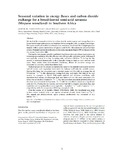| dc.description.abstract | We studied the seasonal variation in carbon dioxide, water vapour and energy fluxes in a broad-leafed semi-arid savanna in Southern Africa using the eddy covariance technique. The open woodland studied consisted of an overstorey dominated by Colophospermum mopane with a sparse understorey of grasses and herbs. Measurements presented here cover a 19-month period from the end of the rainy season in March 1999 to the end of the dry season September 2000.
During the wet season, sensible and latent heat fluxes showed a linear dependence on incoming solar radiation (I) with a Bowen ratio (β) typically just below unity. Although β was typically around 1 at low incoming solar radiation (150 W m−2) during the dry season, it increased dramatically with I, typically being as high as 4 or 5 around solar noon. Thus, under these water-limited conditions, almost all available energy was dissipated as sensible, rather than latent heat.
Marked spikes of CO2 release occurred at the onset of the rainfall season after isolated rainfall events and respiration dominated the balance well into the rainfall season. During this time, the ecosystem was a constant source of CO2 with an average flux of 3–5 μmol m−2 s−1 to the atmosphere during both day and night. But later in the wet season, for example, in March 2000 under optimal soil moisture conditions, with maximum leaf canopy development (leaf area index 0.9–1.3), the peak ecosystem CO2 influx was as much as 10 μmol m−2 s−1. The net ecosystem maximum photosynthesis at this time was estimated at 14 μmol m−2 s−1, with the woodland ecosystem a significant sink for CO2. During the dry season, just before leaf fall in August, maximum day-and night-time net ecosystem fluxes were typically −3 μmol m−2 s−1 and 1–2 μmol m−2 s−1, respectively, with the ecosystem still being a marginal sink.
Over the course of 12 months (March 1999–March 2000), the woodland was more or less carbon neutral, with a net uptake estimated at only about 1 mol C m−2 yr−1. The annual net photosynthesis (gross primary production) was estimated at 32.2 mol m−2 yr−1. | en_US |

